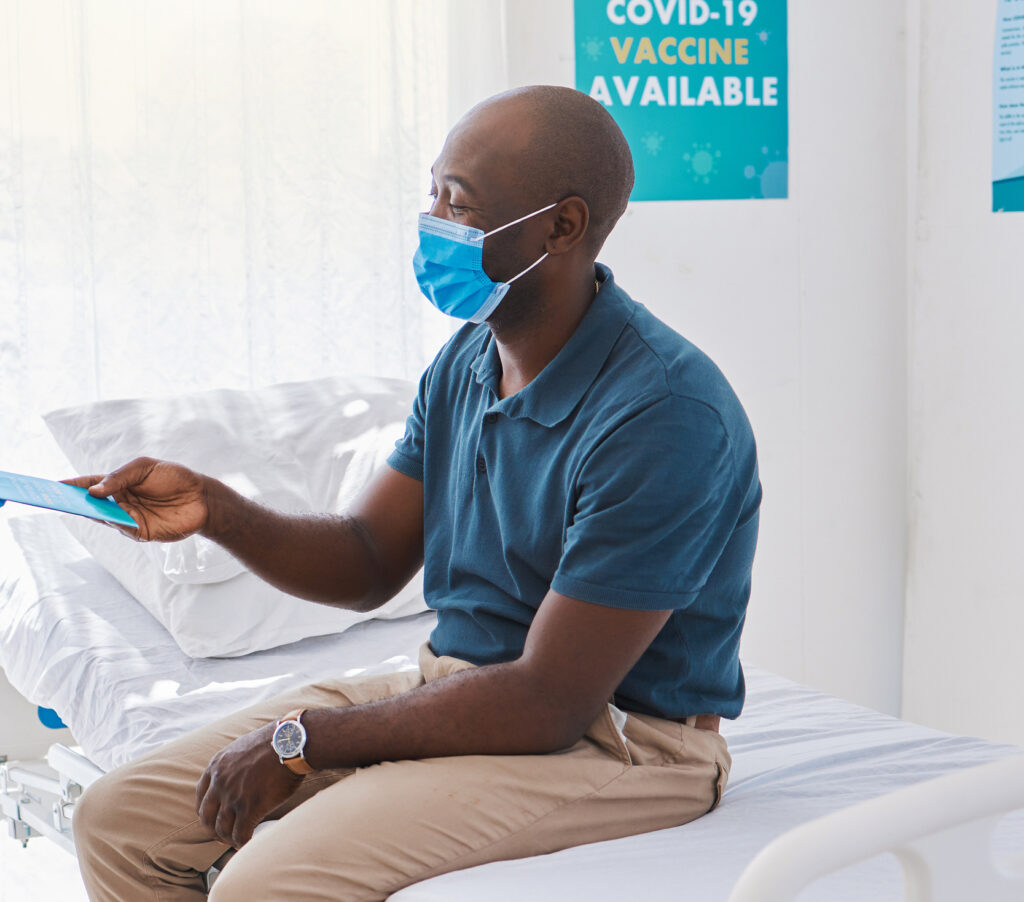Prostate cancer is one of the most prolific cancers among men across the United States, second only to skin cancers. However, Black people carry a heavier burden, are more likely to develop it, and less likely to get early detection screening. The Black population is also twice as likely to suffer fatalities from aggressive prostate cancers as their White counterparts who develop prostate cancer. What is prostate cancer? What are the symptoms? How is it treated? And why are Black people at such high risk? Learn more below.
Symptoms of Prostate Cancer
The signs of prostate cancer are relatively easy to notice, especially as the disease progresses, and many are urinary symptoms. However, once these symptoms arise, the prostate gland cancer may have already progressed. This is why early detection is key. Because Black people have a higher risk of developing prostate cancer, they should be vigilant about following up on any of the symptoms below.
- Frequent or painful urination
- Weak urine stream
- Urinary incontinence
- Blood in semen or urine
- Painful ejaculation
- Decrease in the amount of ejaculate
- Erectile dysfunction
- Pain in the back, hips, or thighs
- Unintentional weight loss
- Decline in overall health
Prostate Cancer Risk Factors
The three most significant risk factors for prostate cancer are age, family history, and race. Researchers have found that Black people have a much higher chance of developing prostate cancer than other races. However, there are additional risk factors that may determine whether your prostate cancer is slow-growing versus aggressive and more likely to metastasize, or spread to other organs once prostate cancer starts. These risk factors include:
- A sedentary lifestyle
- High calcium intake
- Poor diet
- Being tall
- Close family history
- Benign Prostatic Hyperplasia (BPH)
- Prostatitis (prostate infection)
- Agent Orange exposure
Unfortunately, there are a lot of myths about risk factors for prostate cancer, including vasectomy, increased sexual activity, alcohol intake, and taking certain supplements like Vitamin E. If you are concerned about high risk for prostate cancer, discuss it with your health care provider and the possibility of early detection screening.
Prostate Cancer Treatment
There are many treatment options available to those with prostate cancer. Once prostate cells have changed, a prostate biopsy can help determine the Gleason Score and the TNM Score. These, together, help determine the stage and likelihood of the abnormal cells spreading. They also help your health care team create a personalized treatment plan that will be most effective against the abnormal cells.
Possible Prostate Cancer Treatment Options:
- Active Surveillance: Also called “watch and wait,” it is recommended for low-grade cancers with little likelihood of spreading. Doctors may not recommend it for Black people.
- Radical Prostatectomy: Removing the prostate may also remove the cancer and prevent it from spreading if it is has not spread but may be aggressive.
- Radiation Therapy: Radiation can be performed externally or internally, depending on what may be best to treat your specific type and stage of prostate cancer.
- Freezing or Heating: Cryotherapy (freezing) or high intensity focused ultrasound (heating) is an option for small, localized cancers that are caught early.
- Hormone Therapy: Hormone therapies keep your body from producing testosterone or keep it from reaching the abnormal cells. These treatment options are used along with others. This includes androgen deprivation therapy.
- Chemotherapy: This is a very typical cancer treatment used for many cancers that have spread to other regions throughout the body.
- Immunotherapy: Immunotherapy can change and support your body’s immune system, helping it to fight the cancer on its own.
- Targeted Drug Therapy: These therapies target your specific type of cancer cells with medications designed for them and are most effective at treating recurrent prostate cancer.
Screening Options and Diagnosis
There is no routine test for prostate cancer screening. However, there are several methods for screening that your healthcare provider may suggest based on your age and potential risk factors. Providers should consider early screening for the Black population as, most times, prostate cancer starts earlier and more aggressive than those in other ethnic groups.
- Digital Rectal Exam (DRE): Also called a physical exam, your provider performs this in the clinic.
- Prostate-Specific Antigen (PSA) Test: Your provider may offer a less invasive lab test to detect any potential health concerns related to the prostate. It’s important to note that it could be prostate cancer or something benign like an infection or benign prostatic hyperplasia, a noncancerous but enlarged prostate.
- PCA3 RNA: Genetic tests may rule out or confirm prostate cancer prior to scheduling a biopsy on a suspected tumor.
If results are positive or inconclusive, a prostate biopsy will be done to confirm prostate cancer. Other tests could include transrectal ultrasound or MRI done alone or with a biopsy to locate a potential tumor. The biopsy tissue is then tested to determine the stage of the disease and the Gleason Score, which helps providers predict how likely the cancer is to spread.
Prostate Cancer and African Americans
It’s important to understand that prostate cancer is the second most common cancer among men. While it is quite common, the survival rates are mostly positive when caught in the early stages, even for African American men. Government agencies, the health care community, and the Black community should address the fact that, according to the statistics, Black people are still at much higher risk than other races.
The Statistics
Fewer men are dying from prostate cancer according to a literature review by the American Cancer Society Journal. The 2022 publication considered numbers from 2012 to 2016. During these years, the death rates for Black men reduced significantly from 81.9 to 39.8 deaths per 100,000 patients. For White men, the death rates declined from 37 to 19 over the same period. The gap is narrowing but still not enough, as the number of Black men dying from prostate cancer is still double that of non-Hispanic White men.
A 2020 study published via JAMA looked closely at active surveillance, also called “watching and waiting,” that is often prescribed for prostate cancer patients. This is because many diagnoses rarely progress to a life-threatening, advanced stage of the disease. A regular blood test can help determine if the cancer is worsening. However, a 2020 study has determined that more African American men experienced disease progression leading to advanced-stage prostate cancer treatment with this method. Nearly 60% of those choosing active surveillance required treatment for disease progression versus just over 40% for White people.
Tumor Variations and Cancer Advancement
The National Cancer Institute has found that, while the rates of death were similar for both Black and White males for more advanced disease, the Black population had much higher rates for low-grade prostate cancer. Scientists are still working to uncover the reasons for this. However, researchers have suggested differences in the tumors themselves. Studies of tumor genomics comparing prostate cancers of both Black and non-Hispanic White men show that those in the Black population are more likely to be aggressive, metastasizing to nearby tissue or progressing to advanced stage cancer much sooner. Another suggested cause for higher risk of death could be tumor location. Tumors in the anterior region are harder to detect and biopsy.
Barriers to Care
A Black person faces many barriers to care regardless of gender or potential diagnosis. For men, that includes prostate cancers.
Delayed Cancer Screenings
One of the most significant hurdles to quality care that much of the Black population faces in diagnosing any chronic health condition is communication with their providers. There are fewer Black providers and a smaller number that are aware of conditions that disproportionately affect the Black population. If a health care provider doesn’t understand the way prostate cancer can affect a Black patient, they may not suggest early detection screening.
Less Access to Treatment Options
Dr. Abdollah of Henry Ford Health in Michigan suggests several reasons the Black population is at risk for reduced access to proper medical care. The first and most significant cause is bias, both in the health care community and from the Black community. Closely related to bias is stigma. We often see prostate cancers in a different light than others, especially for Black men, mainly because of the sexual health component. Some patients delay care long after symptoms start even if they are aware of them because of this stigma. Unfortunately, much of the Black population is not aware of prostate cancer symptoms or risk factors, so they may not reach out to a health care provider for early detection.
Other factors affecting reduced access to care, according to Dr. Abdollah, include a lack of access to quality health centers, mistrust in the health care system due to past experiences, not having proper health insurance, and fewer early detection cancer screenings.
Fewer Health Education Resources
Education about prostate cancer typically comes from primary health care providers who are the first point of contact for most Black patients. A lack of culturally aware providers can lead to miscommunication about resources, such as prostate cancer screening. Once a patient receives a diagnosis, education about prostate cancer and community resources can be limited if a provider is unaware of those available. Treatment resources could be available, but with no access to them simply because a patient doesn’t know they exist.
Black Men and Clinical Trials
Also covered in the American Cancer Society Journal literature review are the statistics for clinical trial participation. While the Black population is considerably more affected by prostate cancer, the vast majority of those taking part in studies are non-Hispanic White men. This dramatically skews the results of such studies and makes it nearly impossible to account for the underlying causes for the disparities in both causes and effective treatment options for African American men.
It seems there are many reasons for the underrepresentation of Black adults in clinical trials. The first is that low income directly affects educational attainment. This includes education about screening, treatment options, as well as available clinical trials. African Americans are also less likely to live near research hospitals conducting studies. Those that do may not understand the reasoning for them or have a mistrust of clinical trials over traditional, proven medical care.
There may also be barriers for African Americans who wish to join clinical trials. Many studies are designed in such a way to exclude certain participants. Many of these exclusions unfairly target the Black population.
In All…
Prostate cancer begins when prostate cells change into abnormal ones. While they aren’t always life-threatening, they can be much more aggressive in Black people than in other races. Therefore, it is vital that the Black population know their risk and follow up with their health care providers for early detection and screening, plus treatment if needed. Black Health Matters is helping to spread awareness of the disparities that Black people face, increasing education, screenings, and treatment options available for all.








